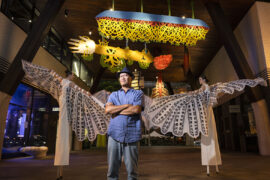British designer Morag Myerscough had to meet strict clinical regulations to bring her bright colours and harlequin prints to life in the Sheffield Children’s Hospital, not to mention entirely rethinking the idea of what healthcare spaces should look like.
Myerscough was invited by Artfelt, the Children’s Hospital Charity’s arts programme, to design the interiors for wards of the Sheffield Children’s Hospital.
The objective was to make the rooms feel more comfortable and domestic. Although children’s rooms might seem perfectly suited to Myerscough’s colourful, graphic style, the design process was not straightforward. Here, paler colour schemes we used to suit children with autism or others who have an intolerance to bright patterns.
She also wanted the rooms to feel appropriate to older children. Besides the colours and patterns, a defining feature of the space is its relative lack of medical equipment. A lot of the cables and devices are stored behind the Formica panels, giving the space a more comforting, home-like feel.
“Although the rooms are for children, I didn’t want them to be childish because children of all different age groups will be staying in them,” said Myerscough. “I also wanted to create somewhere parents would be happy to spend time too. It was just about making a bedroom that you felt good to be in.”
In addition, the hospital environment required that everything be sterile and easy to clean, so Myerscough had to work entirely with plastic laminate. The wood-like panels in the wards is Formica, which has the woodgrain screen-printed onto paper and then laminated. Painting directly onto the Formica wasn’t possible, and neither was screen-printing additional colours onto the paper.
“To get the really pure colours that I wanted, I had hoped to screen print my own pattern onto the existing wood grain,” Myerscough said. “Unfortunately we couldn’t do that because you can only screen print one or two colours onto the paper before it disintegrates.” In the end she ended up scanning the wood grain and digitally adding patterns to it. That combined pattern was then printed onto paper and laminated like normal Formica.
INDESIGN is on instagram
Follow @indesignlive
A searchable and comprehensive guide for specifying leading products and their suppliers
Keep up to date with the latest and greatest from our industry BFF's!

Merging two hotel identities in one landmark development, Hotel Indigo and Holiday Inn Little Collins capture the spirit of Melbourne through Buchan’s narrative-driven design – elevated by GROHE’s signature craftsmanship.

For a closer look behind the creative process, watch this video interview with Sebastian Nash, where he explores the making of King Living’s textile range – from fibre choices to design intent.

Launched in 2015, the China Good Design award showcases international design tailored to the Chinese market.
People with a penchant for pets and design can now house their dogs in clean-lined contemporary kennels
The internet never sleeps! Here's the stuff you might have missed

Unveiled at Barangaroo South, Indonesian–Australian artist Jumaadi’s first permanent public artwork layers sculpture, sound and shadow to reimagine how art is encountered in the city.

At the National Wool Museum, a new exhibition traces the evolution of Godfrey Hirst and its long-standing role in shaping Geelong’s industrial and design identity.